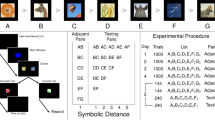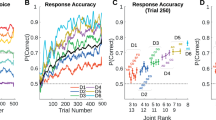Abstract.
This study evaluated the role of several different training procedures on (1) efficiency of acquisition and (2) organizational characteristics of memory for lists that could be serially ordered. Five macaque monkeys were trained via two-choice object discriminations in a formboard apparatus on several five-item-series tasks that provided different levels of intrasession conditionality. Although ease of acquisition differed for subsets of the constituent pairs, concurrent inclusion of the four premise pairs that defined a list required equivalent amounts of training on every task. All training procedures yielded similar retention-test performances and showed common organizational properties (on both error and latency measures) consistent with the view that lists were retained as internally represented ordered series. Test outcomes emphasized the need for integrated exposition of all concurrent conditional relationships to allow appropriate tests of serial organization. However, if given such training, the monkeys revealed integrated serial memory even though they had never seen many of the possible novel combinations of list items. In overview, their performances offered further definition of the procedures required for valid assessment of inferential properties in comparative cognition.
Similar content being viewed by others
Author information
Authors and Affiliations
Additional information
Electronic Publication
Rights and permissions
About this article
Cite this article
Treichler, R.F., Van Tilburg, D. Premise-pair training for valid tests of serial list organization in macaques. Anim Cogn 5, 97–105 (2002). https://doi.org/10.1007/s10071-002-0135-x
Received:
Revised:
Accepted:
Issue Date:
DOI: https://doi.org/10.1007/s10071-002-0135-x




